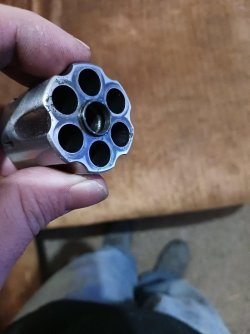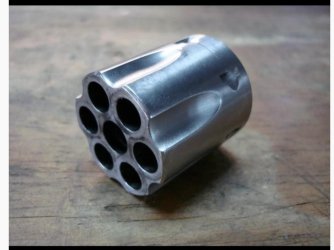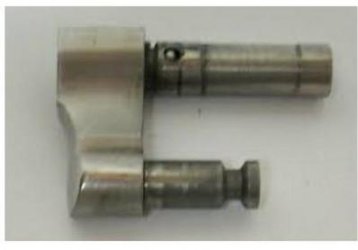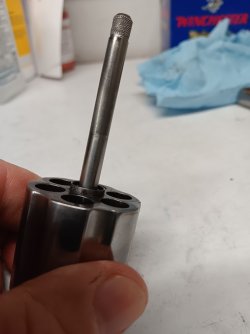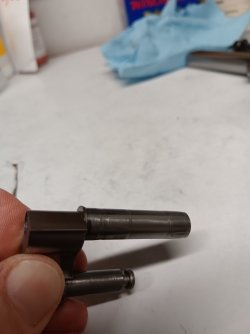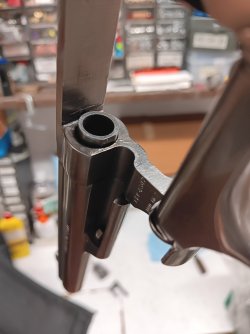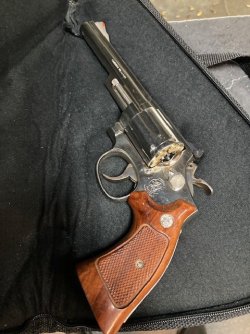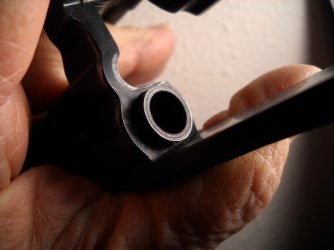magnum0710
Member
- Joined
- Jan 16, 2024
- Messages
- 74
- Reaction score
- 63
I know what you're thinking "oh no not another K frame forcing cone thread" but yes I'm going there one more time. I just watched a video on the K frame forcing cone issue and while the guy made some good points I still think it's not nearly as big a deal as it's made out to be.
Apparently moving the gas ring from the front of the cylinder to the yoke required more metal to be taken off the forcing cone and this was during the 70s. Model 19-4s and no dash 66s had the yoke mounted gas ring. Then when they put the gas ring back on the cylinder they didn't go back to the original spec. I made a comment on the video and theres a whole other side to this people don't know about.
The Ruger Security Six (and its variants) had a full forcing cone for most of its production life. It also didn't have a gas ring on the cylinder, it was part of the yoke (crane in Ruger terminology). That allowed Ruger to have a full forcing cone in a k frame sized revolver. There's obviously some difference between the two considering it required S&W to take off more metal from the forcing cone but in theory it should've allowed them to take less metal off than before.
Sometime around 1984-1985 Ruger moved the gas ring to the front of the cylinder which required the same relief cut as the K frames. What's crazy is you never hear of an issue with the Rugers that have the flat spot. The SP101 also had the flat spot for most of its life and again you never hear of an issue. Sometime in the last 10 years or so they were able to have a full forcing cone but I've seen many SP101s with the flat spot. Perhaps it's a difference in metallurgy, or because the Rugers we're designed for 357 in the first place, maybe their design allowed them to leave more metal than S&W, I don't know. I just find it odd that there are so many complaints about vintage K frames and the forcing cone yet you never hear of an issue with Ruger. I have a couple of the late model Six series revolvers with the relief cut, one has seen a good amount of full power 357 and shows no sign of developing an issue.
I believe the K frame forcing cone issue was a perfect storm of things. The gas ring change requiring more metal be taken off, police starting to practice and qualify with magnum ammo rather than just carrying it, along with the hot 125 and 110 grain ammo coming into vogue around this time. I'm not going to say it was only lighter bullets that did it but most of the cracked forcing cones seem to have been from steady use of 125 and 110 grain flamethrowers.
We have to keep in mind that SAAMI lowered the specs for 357 in the 1990s so today's 357 isn't what it was in the 70s and 80s. The reloading world really puts things into perspective also. When the forcing cones were thinned further is around the same time as Speer #8, none of today's manuals are even close to the max loads that were in the 70s and 80s manuals. I have 38+p data from 1992 that today's data doesn't even touch. A lot of police even carried hand loads back then, some departments had reloading benches and would load their own practice ammo. Loads that were normal and considered safe back then are known to be over pressure today. I have to assume the ammo companies probably loaded hotter back then simply because pressure testing back then wasn't as precise as it is today. I'm sure the ammo itself was a big contributor to this, especially with lighter bullets. I also have to think that powder selection may have played a role as well. Some powders burn hotter than others. Feed a vintage K frame nothing but 158 grain loads using HS6 and it'll probably last a life time, switch to 125s and Lil Gun and it'll probably wreck you're forcing cone in short order. Think about Speer #8, no one will even dare to quote loads from that particular manual because they're that dangerous. How many K frames were subjected to loads from that manual? Even an N frame or GP100 wouldn't stand up to long term abuse from the loads in Speer #8.
I have to believe with modern ammo and bullets over 125 grain that a vintage K frame 357 would hold up just fine. Especially if you're a reloader and you're using 158s below max loads. If they were truly these delicate butterfly's that they're made out to be I highly doubt there would still be thousands if not millions of them in the wild today and they certainly wouldn't be as sought after as they are. I'm not saying it didn't or doesn't happen but I don't think the issue is as big as it's made out to be. I've only ever seen it in pictures. Yes the k frames were intended for practice with 38 and carry 357, but we now have J frames and really small 357s with very thin forcing cones that hold up just fine. We also have the Golden Saber and Gold Dot Short Barrel that are far from full power yet still above 38+p. There's also the Buffalo Bore and Underwood 38+p loads that are about equal to the 38/44 loads. I dont think it's necessary to baby a vintage K frame with the lightest target loads possible just because of the forcing cone. I think they can handle modern 158s, the lighter defense loads and the 38/44 type loads just fine.
Maybe I'm missing something here but I just don't think that it's the widespread issue that it's made it out to be. I wouldn't shoot nothing but 125s and max charges of Lil Gun or H110 but I wouldn't do that with a 686 either. Abuse can ruin any gun, take care of it and it'll take care of you.
Apparently moving the gas ring from the front of the cylinder to the yoke required more metal to be taken off the forcing cone and this was during the 70s. Model 19-4s and no dash 66s had the yoke mounted gas ring. Then when they put the gas ring back on the cylinder they didn't go back to the original spec. I made a comment on the video and theres a whole other side to this people don't know about.
The Ruger Security Six (and its variants) had a full forcing cone for most of its production life. It also didn't have a gas ring on the cylinder, it was part of the yoke (crane in Ruger terminology). That allowed Ruger to have a full forcing cone in a k frame sized revolver. There's obviously some difference between the two considering it required S&W to take off more metal from the forcing cone but in theory it should've allowed them to take less metal off than before.
Sometime around 1984-1985 Ruger moved the gas ring to the front of the cylinder which required the same relief cut as the K frames. What's crazy is you never hear of an issue with the Rugers that have the flat spot. The SP101 also had the flat spot for most of its life and again you never hear of an issue. Sometime in the last 10 years or so they were able to have a full forcing cone but I've seen many SP101s with the flat spot. Perhaps it's a difference in metallurgy, or because the Rugers we're designed for 357 in the first place, maybe their design allowed them to leave more metal than S&W, I don't know. I just find it odd that there are so many complaints about vintage K frames and the forcing cone yet you never hear of an issue with Ruger. I have a couple of the late model Six series revolvers with the relief cut, one has seen a good amount of full power 357 and shows no sign of developing an issue.
I believe the K frame forcing cone issue was a perfect storm of things. The gas ring change requiring more metal be taken off, police starting to practice and qualify with magnum ammo rather than just carrying it, along with the hot 125 and 110 grain ammo coming into vogue around this time. I'm not going to say it was only lighter bullets that did it but most of the cracked forcing cones seem to have been from steady use of 125 and 110 grain flamethrowers.
We have to keep in mind that SAAMI lowered the specs for 357 in the 1990s so today's 357 isn't what it was in the 70s and 80s. The reloading world really puts things into perspective also. When the forcing cones were thinned further is around the same time as Speer #8, none of today's manuals are even close to the max loads that were in the 70s and 80s manuals. I have 38+p data from 1992 that today's data doesn't even touch. A lot of police even carried hand loads back then, some departments had reloading benches and would load their own practice ammo. Loads that were normal and considered safe back then are known to be over pressure today. I have to assume the ammo companies probably loaded hotter back then simply because pressure testing back then wasn't as precise as it is today. I'm sure the ammo itself was a big contributor to this, especially with lighter bullets. I also have to think that powder selection may have played a role as well. Some powders burn hotter than others. Feed a vintage K frame nothing but 158 grain loads using HS6 and it'll probably last a life time, switch to 125s and Lil Gun and it'll probably wreck you're forcing cone in short order. Think about Speer #8, no one will even dare to quote loads from that particular manual because they're that dangerous. How many K frames were subjected to loads from that manual? Even an N frame or GP100 wouldn't stand up to long term abuse from the loads in Speer #8.
I have to believe with modern ammo and bullets over 125 grain that a vintage K frame 357 would hold up just fine. Especially if you're a reloader and you're using 158s below max loads. If they were truly these delicate butterfly's that they're made out to be I highly doubt there would still be thousands if not millions of them in the wild today and they certainly wouldn't be as sought after as they are. I'm not saying it didn't or doesn't happen but I don't think the issue is as big as it's made out to be. I've only ever seen it in pictures. Yes the k frames were intended for practice with 38 and carry 357, but we now have J frames and really small 357s with very thin forcing cones that hold up just fine. We also have the Golden Saber and Gold Dot Short Barrel that are far from full power yet still above 38+p. There's also the Buffalo Bore and Underwood 38+p loads that are about equal to the 38/44 loads. I dont think it's necessary to baby a vintage K frame with the lightest target loads possible just because of the forcing cone. I think they can handle modern 158s, the lighter defense loads and the 38/44 type loads just fine.
Maybe I'm missing something here but I just don't think that it's the widespread issue that it's made it out to be. I wouldn't shoot nothing but 125s and max charges of Lil Gun or H110 but I wouldn't do that with a 686 either. Abuse can ruin any gun, take care of it and it'll take care of you.

